Royal National Orthopaedic Hospital
234 Great Portland Street, W1N 6AD
Medical dates:
Medical character:
1905 - 1984
Specialist
In August 1905, following an initiative by the King Edward's Hospital Fund (later the King's Fund) to rationalise orthopaedic services in London, the Royal Orthopaedic Hospital and the National Orthopaedic Hospital merged (the City Orthopaedic Hospital in Hatton Garden desisted, at least for the moment, having just refurbished its buildings). The new amalgamation was named the Royal National Orthopaedic Hospital for the Treatment and Cure of all Crippled and Deformed Patients.
The Royal Orthopaedic Hospital moved from Hanover Square into the premises of the National which, at that time, consisted of a wing with 60 beds on the Great Portland Street side of the site, newly built in 1893, and a collapsing old building over 200 years old on the Bolsover Street side (the Hospital also owned the leases of Nos. 47, 54, 55, 56 and 57 Bolsover Street and of No. 234 Great Portland Street).
The first annual meeting of the newly merged Hospital, held on 28th February 1906, gratefully recorded the consent of the King and Queen to become Patron and Patroness, and the granting of a Royal Charter.
A major rebuilding programme for a new hospital with every modern appliance was initiated, to be partly funded by the sale of the Hanover Square premises (the freehold of which had been sold for £40,000). The premises of the National Orthopaedic Hospital were all leasehold properties, part of the Howard de Walden and Portland estates. The King Edward's Hospital Fund decided a new, large hospital should be built on the site by obtaining the leases of adjacent properties.
In 1907 the City Orthopaedic Hospital, in financial difficulties, agreed to merge with the Royal National Orthopaedic Hospital. The proceeds of the sale of its assets - some £5,000 - were used to fund the new building. In 1908 it was estimated that £18,675 would be absorbed by the Out-Patients Department and Nurses' Home to be built on the east side of Bolsover Street, and £49,218 would be needed for the in-patients facilities on the west side of Bolsover Street. Some £25,000 was still needed for the building works.
While the new hospital was being built, it was necessary to find accommodation for the in-patients and, for this purpose, three unoccupied wards at Charing Cross Hospital were rented to provide 50 to 60 beds. The administrative offices and Out-Patients Department remained accommodated in houses in Bolsover Street, for which the National Orthopaedic Hospital had leases.
The new Hospital opened in 1909. The new Out-Patients Department and Nurses' Home, built on the sites of Nos. 49-51 Bolsover Street, were completed first and were officially opened on 20th April 1909 by Princess Alexandra of Teck. On 24th July 1909 King Edward VII, accompanied by Queen Alexandra and Princess Victoria, officially opened the in-patient block, which extended from No. 234 Great Portland Street on its western side (its main entrance) to No. 56 Bolsover Street on its eastern side. A subway under Bolsover Street connected the in-patient and out-patient parts of the Hospital.
The Hospital had 200 beds on four floors but, because of shortage of funds, the fourth floor could not be opened until 1912. The west ward on the first floor was named King's Ward, after King Edward VII, while the second floor ward was named Queen's Ward, after Queen Alexandra. The third floor ward was called Bishop's Ward, after G.F. Bishop, a Trustee and long-time friend of the Hospital, who had died in 1898.
Some 75% of patients were children, afflicted variously with tuberculosis and deformities of the spine or limb. Children undergoing treatment received tuition under the direction of the London Education Committee.
In 1910 a School of Massage was established and a masseuse and a massage instructor appointed. The School had 8 pupils (it closed in 1921 for an unknown reason).
On 10th May 1910 an X-ray apparatus was installed at a cost of £150.
In June 1912 the Lord Mayor of London opened the vacant ward on the fourth floor, which had been named the Annie Zunz Ward.
In 1912 the Hospital Committee decided that the Out-Patients Department and office accommodation were inadequate. In the summer of 1913 an extension to the Out-Patients Department building was mooted, but the outbreak of WW1 delayed the project (building work did not start until 1926).
During WW1 the Hospital offered 100 to 130 beds to the War Office for military cases (the first floor ward was retained for civilian cases). The first military patients were admitted in early October 1914.
In February 1915 the War Office agreed that the military beds should be used only for orthopaedic cases requiring special treatment. By 1917 some 170 beds had been reserved for military patients.
By 1918, at the end of the war, about 18,000 servicemen had been treated at the Hospital. The Ministry of Pensions requested that the Hospital take discharged disabled servicemen instead of serving ones. A wooden hut to accommodate a Curative Workshop to provide massage and electrical treatments was erected on the site of Nos. 45-47 Bolsover Street; a boot repair shop also was established.
Since it had opened in 1909, the number of out-patients attending the Hospital had risen from 11,000 a year to 66,000. The Hospital appointed a Special Committee to decide on future plans, including the delayed enlargement of the Out-Patients Department (now urgent), with workshops in the basement. More accommodation was needed for the resident medical and nursing staff, and also for private patients. It was planned to establish a School of Orthopaedic Surgery, for which a Lecture Room would be needed.
One of the King's Fund stipulations had been that a country branch should be developed in a northern suburb. Springwell Farm in Norwood had been offered by Lord Ebury, but the Committee of Management had managed to postpone setting up a country branch on expense grounds, wanting to wait until the new Hospital had been built and occupied but, with the intervention of WW1, the country branch had been further delayed.
After the war, the Committee had searched for a decommissioned military hospital but the only one available, at Mount Felix, was deemed not suitable. The Facial Hospital at Sidcup was also looked at, but would not be available until the end of 1920. An Appeal to raise £200,000 was launched to raise funds for both the enlargement of the Out-Patients Department and the establishment of a country branch.
In 1920 one of the surgeons, Mr T.H. Openshaw, informed the Committee that the Mary Wardell Convalescent Home in Brockley Hill, Stanmore, was vacant and would be suitable for a country branch. The Committee bought the Home and the Country Branch opened in 1922 for the long-term care and rehabilitation of chronically ill patients.
Plans to extend the Out-Patients Department had not yet been implemented, but the ground landlords, the Audley Trust who owned Nos. 45-51 Bolsover Street on which the extension would be built, had grown impatient at the delay and demanded that a start be made by 1927 at the latest (instead of 1930, which the Hospital had asked for).
In December 1926 a tender of £49,980 was accepted for the building of the extension.
The 3-storey extension of the Out-Patients Department was finally opened on 27th November 1927 by the Lord Mayor of London, in the presence of Prince Henry. The old Out-Patients Department became the Physiotherapy Department.
During WW2 some 35 beds were reserved for urgent orthopaedic cases and 100 for civilian air-raid casualties.
After the war, in 1946, the Institute of Orthopaedics was established as a postgraduate research unit under the aegis of the British Postgraduate Medical Federation. Until accommodation could be built at Stanmore, it occupied the first floor of the Hospital, which had been converted into laboratories, a Lecture Room and a Library. A Medical Photography Department opened in December 1946.
In 1948 the Hospital joined the NHS as a postgraduate teaching hospital under the management of a Board of Governors.
By 1950 specialist out-patient clinics began to be established for scoliosis, spinal tuberculosis, backache, leg inequality, hand disorders and peripheral nerve injuries.
In 1952 plans were made to extend the Hospital to 250 beds and to erect new buildings to house the operating theatre and the kitchen. The estimated cost of both building projects was £100,000, but lack of funds scuppered the work.
In 1959 the Hospital had 90 beds, but the King's Fund considered the wards antiquated and not up to modern standards.
Throughout the 1960s plans to rebuild the Hospital on the car park site were contemplated. The new building would incorporate a Limb Fitting Centre, as accommodation for the service at Queen Mary's Hospital, Roehampton, had become inadequate. Again, the lack of money thwarted the project.
In 1974, after a major reorganisation of the NHS, the Board of Governors was replaced by a Hospital Management Committee (Postgraduate Teaching) under the control of the North East Thames Regional Health Authority. (The Stanmore branch also belonged to the North East Thames Region, although geographically in the North West.) The Hospital had 88 beds, including 10 for private patients.
In 1982, following another major reorganisation of the NHS, the Hospital came under the control of the Bloomsbury District Health Authority, part of the North East Thames Regional Health Authority.
In 1984, when the Hospital had 96 beds, the lease of the main building expired; in-patient services
moved either to the Stanmore branch or
to the Middlesex Hospital
(briefly). Out-patient services remained in Bolsover Street
directly opposite, together with some departments of the Institute of Orthopaedics. The tunnel between the two buildings was
sealed closed.
Present
status (December 2007) |
|---|

The western half of the former Hospital (above and below) is now Consulting Rooms for the Portland Hospital for Women and Children.
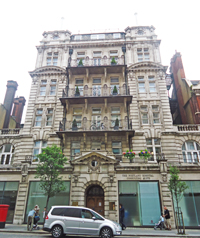
No. 234 Great Portland Street contained the wards and the operating theatres.
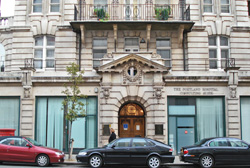
The main entrance.
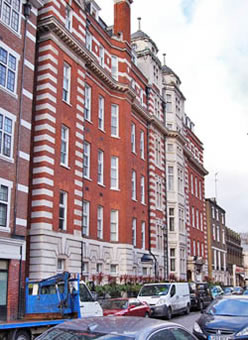
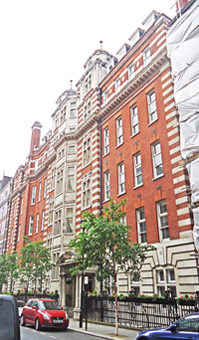
The eastern side of the building in Bolsover Street, as seen from the south (left) and from the north (right). It is now Central Park Lodge, an apartment block.
I used to work in this building and my old
office, along with the Medical Library and Librarian's office, is now a
one-bedroom flat.

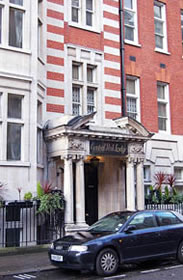
Central Park Lodge.
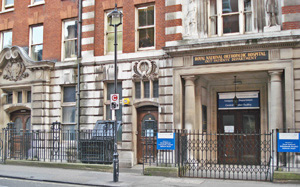
The Out-Patients
Department was directly opposite, on the eastern side of Bolsover Street (which ran between
the sites of the Hospital).
References
(Author unstated) 1906 (untitled) British Medical Journal 1 (2362), 835.
(Author unstated) 1908 The Royal National Orthopaedic Hospital. British Medical Journal 2 (2485), 447.
(Author unstated) 1909 The Hospital World. Royal National Orthopaedic Hospital. British Journal of Nursing, 24th April, 883.
(Author unstated) 1920 The Royal National Orthopaedic Hospital. British Medical Journal 2 (3121), 634-635.
(Author unstated) 1927 Royal National Orthopaedic Hospital: New Out-Patient and Electrical Department. Lancet 210, 1159.
(Author unstated) 1956 Wellcome Museum of Orthopaedics. British Medical Journal 1 (4971), 855.
(Author unstated) 1958 Institute of Orthopaedics. British Medical Journal 2 (5105), 1157.
Cholmeley
JA 1985 History
of the Royal National Orthopaedic Hospital. London, Chapman
& Hall.
Black N 2006 Walking London's
Medical History. London, Royal Society of Medicine Press.
Morley A 1930 Correspondence. Royal National Orthopaedic Hospital. Lancet 216, 273.